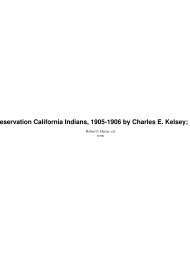the beginning of yosemite tourism - Yosemite Online
the beginning of yosemite tourism - Yosemite Online
the beginning of yosemite tourism - Yosemite Online
- No tags were found...
Create successful ePaper yourself
Turn your PDF publications into a flip-book with our unique Google optimized e-Paper software.
ottles), food and food preparation tool remains, andpharmaceuticals. O<strong>the</strong>r object types, such as structuralremains (nails, glass, etc.), personal objects (tobacco tins,clay pipe fragment), and shell casings, were present, butin much smaller numbers than <strong>the</strong> domestic objects. Themajority <strong>of</strong> <strong>the</strong> objects dated from 1880 to 1910, consistentwith <strong>the</strong> time frames <strong>of</strong> <strong>the</strong> hotel and saloon.When analyzed, artifacts from <strong>the</strong> Hurst Saloon providedevidence <strong>of</strong> trade networks that connected WilliamHurst to his neighbors, local merchants, regional producers,and national and international manufacturers.Although only less than one percent <strong>of</strong> <strong>the</strong> total assemblagecould be identified as to manufacturing origins, <strong>the</strong>manufacturers that could be identified revealed connectionsto communities in California, <strong>the</strong> eastern UnitedStates, and Great Britain.The local network was represented by fragments <strong>of</strong>eggshells. Although it is uncertain where <strong>the</strong> eggs originated,Ann Gobin was known to keep chickens at herhotel across <strong>the</strong> Big Oak Flat Road. These remains mayrepresent <strong>the</strong> tangible expression <strong>of</strong> a system <strong>of</strong> barterknown as “neighboring.” As elaborated by Miner (1949)in his study <strong>of</strong> a farming community in Iowa and later byAdams (1976, 1977) in his study <strong>of</strong> Silcott, neighboringwas an outgrowth <strong>of</strong> a primarily “cashless” or “cash poor”local economy that relied on bartering relationships forgoods and labor.These relationships created social and economicties that resulted in a system <strong>of</strong> alliances and <strong>the</strong> formation<strong>of</strong> community bonds. Given <strong>the</strong> fact that solitaryshepherds, placer miners, farm laborers, and NativeAmericans were Hurst’s primary clientele, this cashlesssystem <strong>of</strong> barter was most likely extensive and mayhave served as <strong>the</strong> basis for <strong>the</strong> local economy atCrane Flat.The regional network was evidenced by a single bottle<strong>of</strong> soda water that was produced at <strong>the</strong> Thomas LeonardSoda Works in Sonora, California. Although this bottleprovides <strong>the</strong> only precise evidence for a regional network,<strong>the</strong> high percentage <strong>of</strong> consumer goods in <strong>the</strong> assemblageshows Hurst’s connection to merchants in <strong>the</strong> area whoprovided such goods.No merchants were identified from <strong>the</strong> archeologicalremains, but fur<strong>the</strong>r historical research, which focuses on<strong>the</strong> account books and inventories <strong>of</strong> nearby merchantsin <strong>the</strong> counties <strong>of</strong> Tuolumne and Mariposa, may allowfor more information about Hurst’s interactions within<strong>the</strong> regional commercial economy. With known rivalriesbetween business interests in Tuolumne and Mariposacounties, this research may provide a better understanding<strong>of</strong> Hurst’s political interests.Fur<strong>the</strong>r inference as to Hurst’s connection to aregional network was made through an analysis <strong>of</strong> <strong>the</strong>ferrous metal cans and can fragments recovered from <strong>the</strong>site. Over 65% <strong>of</strong> <strong>the</strong> assemblage consisted <strong>of</strong> cans andcan fragments, which represented a minimum <strong>of</strong> 132individual cans. This proliferation <strong>of</strong> canned goods at <strong>the</strong>Hurst Saloon coincided with <strong>the</strong> development <strong>of</strong> <strong>the</strong> firstautomated can making machinery in <strong>the</strong> 1880s whichgreatly increased production.The Gobin and Hurst Way Station at Crane Flat in 1901. Photo attributed to Celia Crocker Thompson courtesy <strong>of</strong> <strong>the</strong> <strong>Yosemite</strong> ResearchLibrary.14 Y O S E M I T E A S S O C I A T I O N , S U M M E R 2 0 0 5


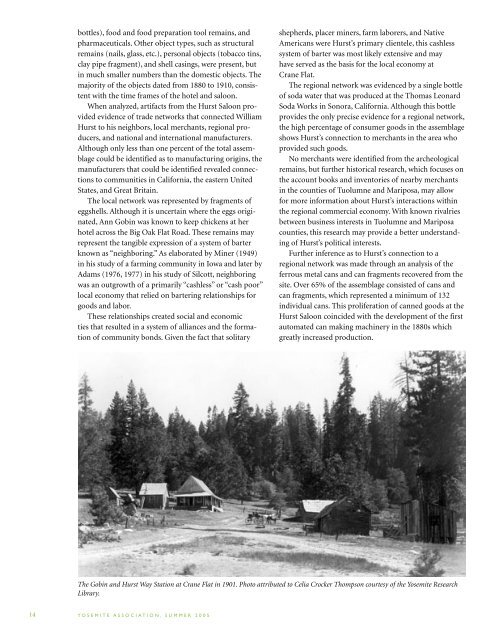

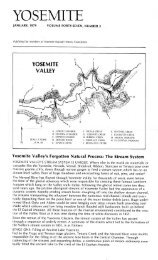
![(March 1982) [PDF] “We Are Pleased to Announce†- Yosemite Online](https://img.yumpu.com/51299748/1/190x242/march-1982-pdf-aeuroewe-are-pleased-to-announceaeur-yosemite-online.jpg?quality=85)
![[PDF] Old Horny, Yosemite's Unicorn Buck - Yosemite Online](https://img.yumpu.com/51269869/1/184x260/pdf-old-horny-yosemites-unicorn-buck-yosemite-online.jpg?quality=85)
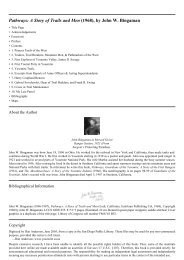
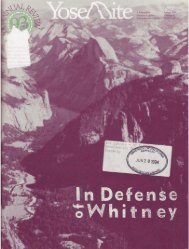
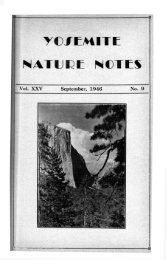
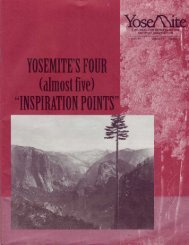
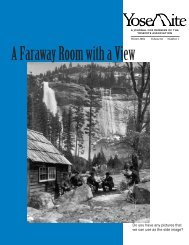
![1985 [PDF] - Yosemite](https://img.yumpu.com/48128837/1/184x260/1985-pdf-yosemite.jpg?quality=85)

